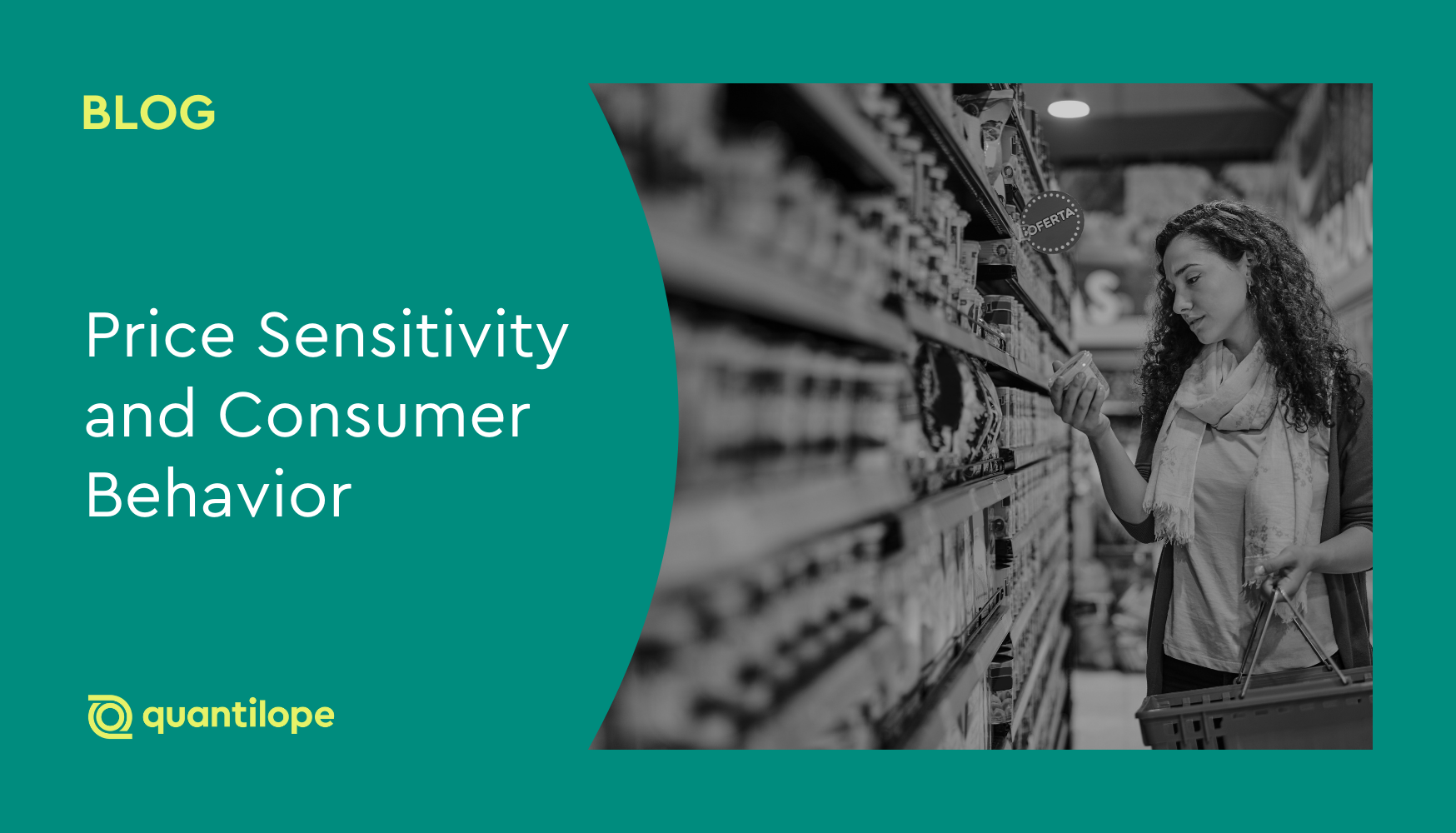Role of price sensitivity in consumer decision-making
Price sensitivity is a huge component in how consumers make purchasing decisions. Every time consumers shop, they’re subconsciously weighing the price of something against the value they think they’ll get from it. As consumers make decisions, they’re often considering their disposable income, the availability of alternative products, how necessary the item is, and how they perceive a brand they’re thinking of purchasing from (i.e. is it worth spending more for that brand over others?).
Someone with a lower disposable spending budget might be highly price-sensitive when grocery shopping, carefully comparing prices and opting for store brands or discounted items. However, that same person might be less price-sensitive when buying a medication prescribed by their doctor, prioritizing their health over potential cost savings. Similarly, a consumer who is loyal to a particular brand of coffee might be willing to pay a premium for it, even if cheaper alternatives exist (more on the role of brand loyalty below).
Businesses can (and should) account for price sensitivity when tailoring their pricing strategies to different consumer segments and market conditions. By analyzing how various factors influence consumers' price perceptions, companies can make informed decisions about pricing, promotions, and new product development.
Back to Table of Contents
Key factors influencing price sensitivity
A number of elements can influence how price-sensitive consumers are to a particular product or service, such as...
Income:
Income levels can affect price sensitivity. Consumers with lower incomes naturally tend to be more price-sensitive than those with higher incomes, meaning an increase in price (even a small one) will likely drive away lower-income earners in favor of cheaper alternatives. Before making pricing changes, brands need to have a strong understanding of who their target market is and what level of discretionary spending those consumers have access to.
Age:
Consumers’ price sensitivity is also related to age (which often coincides with income). For example, college grads right out of school earning their first salary might pay more attention to market prices than those who are older and more established, with more discretionary income. As another example, older consumers may be more conscious of their spending once they retire, while younger consumers are a bit more carefree. Knowing who your target audience is, especially their demographics and income, is key to understanding price sensitivity.
Perceived value:
Customers’ willingness to pay often depends on the perceived value they associate with their purchase. Consumers are less price-sensitive when they believe a product offers a unique or exceptional quality; since they can’t easily pick an alternative brand for that product’s value, they’ll be more willing to pay for it even if the price increases. Alternatively, if the value of a product is low (say, potato chips or deodorant) consumers might opt for a cheaper brand should the price of their typical brand’s product rise. As a brand, consider how you’re adding unique value to your products so that consumers remain loyal.
Brand loyalty:
As mentioned above, brand loyalty can make consumers less sensitive to price changes. Consumers that are loyal to a particular brand may be willing to pay a premium for its products or services even when there are cheaper alternatives. Brands that offer great customer service, unique or high-quality products, and consistent availability (among other factors) are likely to have more loyal customers.
Examples of brand loyalty reducing price sensitivity:
- Apple: Apple customers are notoriously loyal, often willing to pay premium prices for iPhones, Macs, and other Apple products. This loyalty stems from a combination of factors, including a strong brand identity, a perceived higher quality, and a seamless user experience.
- Starbucks: Starbucks has cultivated a loyal customer base by offering a consistent experience, a sense of community, and a rewards program that incentivizes repeat purchases. Many Starbucks customers are willing to pay a premium for their daily coffee fix, even with cheaper options available.
- Nike: Nike's strong brand equity, association with top athletes, and innovative product designs have fostered a loyal following. Consumers are often willing to pay more for Nike shoes and apparel due to the perceived value and brand prestige.
By cultivating brand loyalty, retailers can create a buffer against price sensitivity, allowing them to maintain pricing power and achieve sustainable profitability.
Competitive pricing:
The pricing strategies of competitors also influence price sensitivity. If many similar products or services are available at lower prices and offer comparable value, consumers may be more price-sensitive. To master retail pricing, you need to start by considering why a consumer would pay more for your product if you aren’t offering a differentiated value. Pay attention to competitor prices and adapt your pricing strategy accordingly if you notice consumers are switching to a cheaper substitute.
How competitive markets influence price sensitivity
- Increased price comparison: In competitive markets, information about prices is readily available. Consumers can easily compare prices online, through mobile apps, or by visiting different stores. This transparency makes consumers more sensitive to price variations.
- Abundance of alternatives: Similar to the above, with their wide array of choices, consumers are less likely to feel bound to a particular brand or product. They can easily switch to a competitor offering a better price at any time.
- Price becomes a differentiator: When products are similar in features and quality, price becomes a key differentiator. Companies may be tempted to lower prices to gain a competitive edge, leading to price wars and downward pressure on prices. As mentioned above, this is why creating differentiated value is so important.
Economic conditions:
As hard as a brand works to maintain customer loyalty and offer high value products, they can’t avoid certain economic conditions such as a recession or inflation. These conditions can make consumers more price sensitive, simply because they need to be more conscious of spending than they typically are. They might have to opt for cheaper alternatives, even over brands they’re particularly loyal to or (in normal circumstances) would pay a premium for.
Back to Table of Contents
How to use price sensitivity data to optimize pricing, discount, and promotional strategies
Businesses can use price sensitivity data to optimize their pricing strategies. By understanding how consumers respond to different price points, companies can set prices that maximize profitability while still remaining competitive. Price sensitivity data can also inform discount and promotional strategies.
To leverage price sensitivity for price setting, companies can adopt several strategies:
- Value-Based Pricing: Clearly communicate the value proposition to justify higher pricing.
- Loyalty Programs: Build brand loyalty (a key factor in price sensitivity) through rewards programs, personalized experiences, and strong customer relationships.
- Targeted Promotions: Offer targeted discounts and promotions to attract price-sensitive segments without eroding overall profitability.
Back to Table of Contents
Examples of price sensitivity in different industries
Price sensitivity varies significantly across different industries due to factors like product necessity, availability of substitutes, and consumer perception.
Below are some general examples, though remember that not all consumers shopping for these products or services will be price sensitive:
Consumer Electronics
Smartphones, laptops, and TVs can be highly price-sensitive. Price sensitive tech consumers meticulously compare features and prices, often opting for cheaper alternatives with comparable specifications. Sales and discounts heavily influence purchasing decisions in this market.
Fast Fashion
Trend fluctuations are common in the fashion industry, and consumers are often looking for affordable options to keep up. This makes fast fashion extremely price-sensitive. Even small price differences can significantly impact sales volume.
Groceries
Everyday essentials like groceries exhibit high price sensitivity. Consumers readily switch brands or stores for better deals on comparable products. Price-conscious shoppers often utilize coupons, compare unit prices, and seek out store-brand options for the right price.
Airlines
Airline tickets are notoriously price-sensitive. Travelers frequently compare fares across different airlines and dates, making price a major factor in their booking decisions. Airlines use dynamic pricing strategies to adjust fares based on demand, time of booking, and competition.
Streaming Services
The increasing number of streaming services like Netflix, Amazon Prime Video, Disney+, and Hulu have heightened price sensitivity in this market. Consumers are becoming more selective about which services they subscribe to, and price plays a significant role in those decisions. Free trials and promotional offers heavily influence consumer choice.
Ride-Sharing Services
The competition between ride sharing services like Uber and Lyft have led to dynamic pricing models and frequent promotions, as both companies strive to attract price-sensitive riders. If the price isn’t right, consumers may instead opt for public transportation, taxi/cab services, or personal vehicles when able.
___
The examples above are just a few that demonstrate how price sensitivity varies across industries and is influenced by a variety of factors. Understanding these nuances is crucial for businesses to determine their optimal price point or acceptable price range.
Back to Table of Contents
Leveraging price sensitivity for competitive advantage with quantilope
quantilope's automated Consumer Intelligence Platform provides businesses with several advanced methodologies to measure price sensitivity for a competitive advantage. With the largest suite of automated advanced methods, quantilope platform users can choose whichever works best for their pricing needs. Regardless of the method, quantilope’s platform includes:
- Real-time respondent data: Track price sensitivity data in real-time to adapt to changing market dynamics as they’re happening.
- Pricing research templates: Start with a pre-built pricing template to ensure you ask the right market questions, or, build your own pricing study from scratch using drag & drop question modules.
- Advanced analytics: Uncover detailed, actionable insights into consumer purchasing behaviors and price perceptions.
- AI-driven recommendations: Leverage the platform’s AI co-pilot, quinn, for price sensitivity analysis, chart headlines, and key takeaways to make strong business recommendations.
To learn more about quantilope and its pricing research solutions to understand price sensitivity, get in touch below!




.png)
